ComfortDelgro: VUCA Analysis, Training Needs, and Future Goals
VerifiedAdded on 2022/08/18
|6
|1996
|12
Report
AI Summary
This report provides a comprehensive analysis of ComfortDelgro, a major land transport company, focusing on its internal and external operational environments. The study utilizes the VUCA (Volatility, Uncertainty, Complexity, and Ambiguity) framework to assess the impact of factors such as the rise of autonomous vehicles, market competition, and technological advancements on ComfortDelgro's business goals and manpower needs. It identifies key areas of volatility and uncertainty, particularly concerning the development and adoption of autonomous vehicles. The report proposes SMART goals, including specific training programs for employees, and outlines the necessary knowledge, skills, and abilities required to adapt to the changing industry landscape. It also includes a task analysis of various roles within the company, such as technical assistants, vehicle testers, and safety operators, and analyzes the drivers of learning needs to improve functional abilities. The report concludes by identifying learning outcomes for a training program designed to equip employees with the necessary skills for the future of land transport.
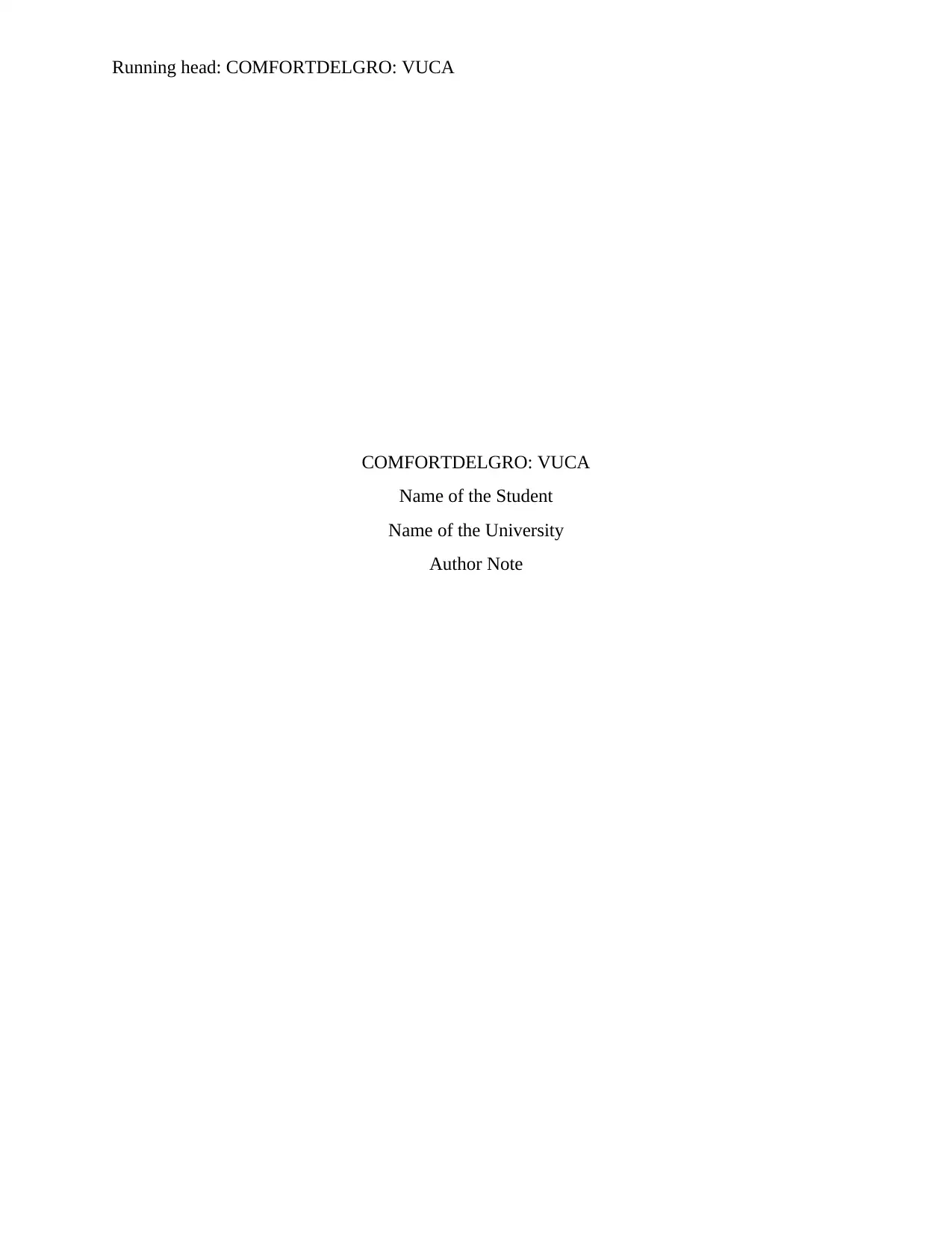
Running head: COMFORTDELGRO: VUCA
COMFORTDELGRO: VUCA
Name of the Student
Name of the University
Author Note
COMFORTDELGRO: VUCA
Name of the Student
Name of the University
Author Note
Paraphrase This Document
Need a fresh take? Get an instant paraphrase of this document with our AI Paraphraser
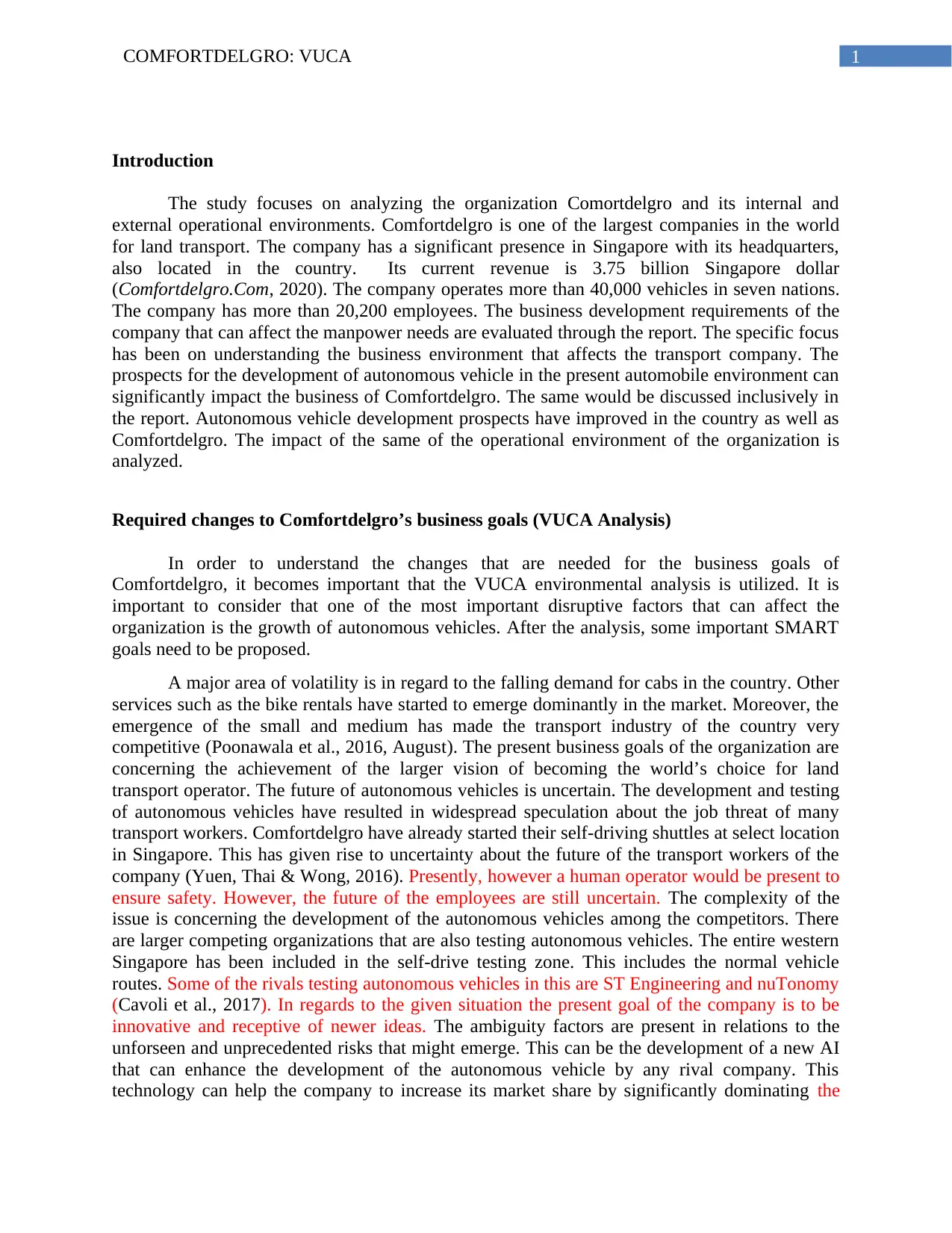
1COMFORTDELGRO: VUCA
Introduction
The study focuses on analyzing the organization Comortdelgro and its internal and
external operational environments. Comfortdelgro is one of the largest companies in the world
for land transport. The company has a significant presence in Singapore with its headquarters,
also located in the country. Its current revenue is 3.75 billion Singapore dollar
(Comfortdelgro.Com, 2020). The company operates more than 40,000 vehicles in seven nations.
The company has more than 20,200 employees. The business development requirements of the
company that can affect the manpower needs are evaluated through the report. The specific focus
has been on understanding the business environment that affects the transport company. The
prospects for the development of autonomous vehicle in the present automobile environment can
significantly impact the business of Comfortdelgro. The same would be discussed inclusively in
the report. Autonomous vehicle development prospects have improved in the country as well as
Comfortdelgro. The impact of the same of the operational environment of the organization is
analyzed.
Required changes to Comfortdelgro’s business goals (VUCA Analysis)
In order to understand the changes that are needed for the business goals of
Comfortdelgro, it becomes important that the VUCA environmental analysis is utilized. It is
important to consider that one of the most important disruptive factors that can affect the
organization is the growth of autonomous vehicles. After the analysis, some important SMART
goals need to be proposed.
A major area of volatility is in regard to the falling demand for cabs in the country. Other
services such as the bike rentals have started to emerge dominantly in the market. Moreover, the
emergence of the small and medium has made the transport industry of the country very
competitive (Poonawala et al., 2016, August). The present business goals of the organization are
concerning the achievement of the larger vision of becoming the world’s choice for land
transport operator. The future of autonomous vehicles is uncertain. The development and testing
of autonomous vehicles have resulted in widespread speculation about the job threat of many
transport workers. Comfortdelgro have already started their self-driving shuttles at select location
in Singapore. This has given rise to uncertainty about the future of the transport workers of the
company (Yuen, Thai & Wong, 2016). Presently, however a human operator would be present to
ensure safety. However, the future of the employees are still uncertain. The complexity of the
issue is concerning the development of the autonomous vehicles among the competitors. There
are larger competing organizations that are also testing autonomous vehicles. The entire western
Singapore has been included in the self-drive testing zone. This includes the normal vehicle
routes. Some of the rivals testing autonomous vehicles in this are ST Engineering and nuTonomy
(Cavoli et al., 2017). In regards to the given situation the present goal of the company is to be
innovative and receptive of newer ideas. The ambiguity factors are present in relations to the
unforseen and unprecedented risks that might emerge. This can be the development of a new AI
that can enhance the development of the autonomous vehicle by any rival company. This
technology can help the company to increase its market share by significantly dominating the
Introduction
The study focuses on analyzing the organization Comortdelgro and its internal and
external operational environments. Comfortdelgro is one of the largest companies in the world
for land transport. The company has a significant presence in Singapore with its headquarters,
also located in the country. Its current revenue is 3.75 billion Singapore dollar
(Comfortdelgro.Com, 2020). The company operates more than 40,000 vehicles in seven nations.
The company has more than 20,200 employees. The business development requirements of the
company that can affect the manpower needs are evaluated through the report. The specific focus
has been on understanding the business environment that affects the transport company. The
prospects for the development of autonomous vehicle in the present automobile environment can
significantly impact the business of Comfortdelgro. The same would be discussed inclusively in
the report. Autonomous vehicle development prospects have improved in the country as well as
Comfortdelgro. The impact of the same of the operational environment of the organization is
analyzed.
Required changes to Comfortdelgro’s business goals (VUCA Analysis)
In order to understand the changes that are needed for the business goals of
Comfortdelgro, it becomes important that the VUCA environmental analysis is utilized. It is
important to consider that one of the most important disruptive factors that can affect the
organization is the growth of autonomous vehicles. After the analysis, some important SMART
goals need to be proposed.
A major area of volatility is in regard to the falling demand for cabs in the country. Other
services such as the bike rentals have started to emerge dominantly in the market. Moreover, the
emergence of the small and medium has made the transport industry of the country very
competitive (Poonawala et al., 2016, August). The present business goals of the organization are
concerning the achievement of the larger vision of becoming the world’s choice for land
transport operator. The future of autonomous vehicles is uncertain. The development and testing
of autonomous vehicles have resulted in widespread speculation about the job threat of many
transport workers. Comfortdelgro have already started their self-driving shuttles at select location
in Singapore. This has given rise to uncertainty about the future of the transport workers of the
company (Yuen, Thai & Wong, 2016). Presently, however a human operator would be present to
ensure safety. However, the future of the employees are still uncertain. The complexity of the
issue is concerning the development of the autonomous vehicles among the competitors. There
are larger competing organizations that are also testing autonomous vehicles. The entire western
Singapore has been included in the self-drive testing zone. This includes the normal vehicle
routes. Some of the rivals testing autonomous vehicles in this are ST Engineering and nuTonomy
(Cavoli et al., 2017). In regards to the given situation the present goal of the company is to be
innovative and receptive of newer ideas. The ambiguity factors are present in relations to the
unforseen and unprecedented risks that might emerge. This can be the development of a new AI
that can enhance the development of the autonomous vehicle by any rival company. This
technology can help the company to increase its market share by significantly dominating the
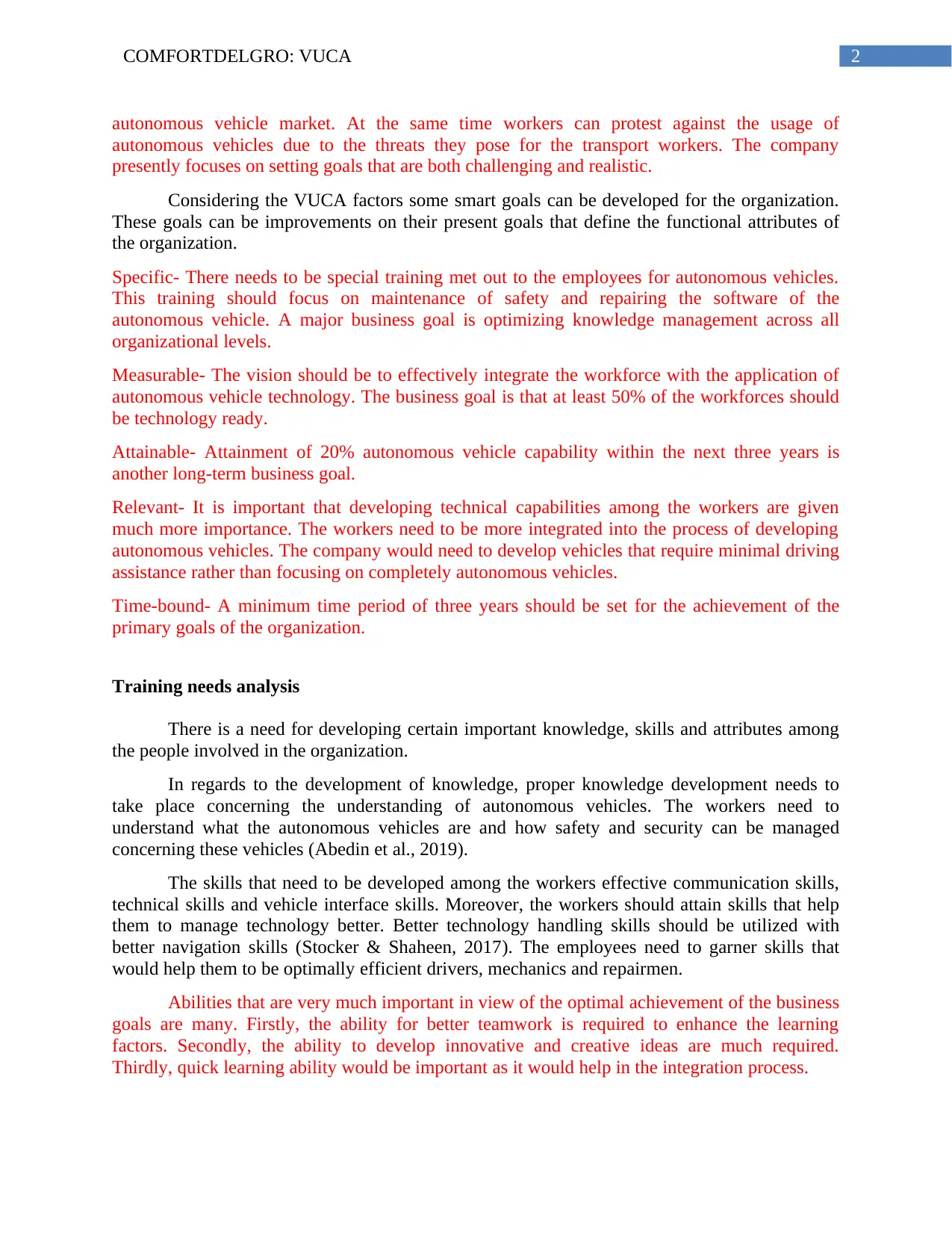
2COMFORTDELGRO: VUCA
autonomous vehicle market. At the same time workers can protest against the usage of
autonomous vehicles due to the threats they pose for the transport workers. The company
presently focuses on setting goals that are both challenging and realistic.
Considering the VUCA factors some smart goals can be developed for the organization.
These goals can be improvements on their present goals that define the functional attributes of
the organization.
Specific- There needs to be special training met out to the employees for autonomous vehicles.
This training should focus on maintenance of safety and repairing the software of the
autonomous vehicle. A major business goal is optimizing knowledge management across all
organizational levels.
Measurable- The vision should be to effectively integrate the workforce with the application of
autonomous vehicle technology. The business goal is that at least 50% of the workforces should
be technology ready.
Attainable- Attainment of 20% autonomous vehicle capability within the next three years is
another long-term business goal.
Relevant- It is important that developing technical capabilities among the workers are given
much more importance. The workers need to be more integrated into the process of developing
autonomous vehicles. The company would need to develop vehicles that require minimal driving
assistance rather than focusing on completely autonomous vehicles.
Time-bound- A minimum time period of three years should be set for the achievement of the
primary goals of the organization.
Training needs analysis
There is a need for developing certain important knowledge, skills and attributes among
the people involved in the organization.
In regards to the development of knowledge, proper knowledge development needs to
take place concerning the understanding of autonomous vehicles. The workers need to
understand what the autonomous vehicles are and how safety and security can be managed
concerning these vehicles (Abedin et al., 2019).
The skills that need to be developed among the workers effective communication skills,
technical skills and vehicle interface skills. Moreover, the workers should attain skills that help
them to manage technology better. Better technology handling skills should be utilized with
better navigation skills (Stocker & Shaheen, 2017). The employees need to garner skills that
would help them to be optimally efficient drivers, mechanics and repairmen.
Abilities that are very much important in view of the optimal achievement of the business
goals are many. Firstly, the ability for better teamwork is required to enhance the learning
factors. Secondly, the ability to develop innovative and creative ideas are much required.
Thirdly, quick learning ability would be important as it would help in the integration process.
autonomous vehicle market. At the same time workers can protest against the usage of
autonomous vehicles due to the threats they pose for the transport workers. The company
presently focuses on setting goals that are both challenging and realistic.
Considering the VUCA factors some smart goals can be developed for the organization.
These goals can be improvements on their present goals that define the functional attributes of
the organization.
Specific- There needs to be special training met out to the employees for autonomous vehicles.
This training should focus on maintenance of safety and repairing the software of the
autonomous vehicle. A major business goal is optimizing knowledge management across all
organizational levels.
Measurable- The vision should be to effectively integrate the workforce with the application of
autonomous vehicle technology. The business goal is that at least 50% of the workforces should
be technology ready.
Attainable- Attainment of 20% autonomous vehicle capability within the next three years is
another long-term business goal.
Relevant- It is important that developing technical capabilities among the workers are given
much more importance. The workers need to be more integrated into the process of developing
autonomous vehicles. The company would need to develop vehicles that require minimal driving
assistance rather than focusing on completely autonomous vehicles.
Time-bound- A minimum time period of three years should be set for the achievement of the
primary goals of the organization.
Training needs analysis
There is a need for developing certain important knowledge, skills and attributes among
the people involved in the organization.
In regards to the development of knowledge, proper knowledge development needs to
take place concerning the understanding of autonomous vehicles. The workers need to
understand what the autonomous vehicles are and how safety and security can be managed
concerning these vehicles (Abedin et al., 2019).
The skills that need to be developed among the workers effective communication skills,
technical skills and vehicle interface skills. Moreover, the workers should attain skills that help
them to manage technology better. Better technology handling skills should be utilized with
better navigation skills (Stocker & Shaheen, 2017). The employees need to garner skills that
would help them to be optimally efficient drivers, mechanics and repairmen.
Abilities that are very much important in view of the optimal achievement of the business
goals are many. Firstly, the ability for better teamwork is required to enhance the learning
factors. Secondly, the ability to develop innovative and creative ideas are much required.
Thirdly, quick learning ability would be important as it would help in the integration process.
⊘ This is a preview!⊘
Do you want full access?
Subscribe today to unlock all pages.

Trusted by 1+ million students worldwide
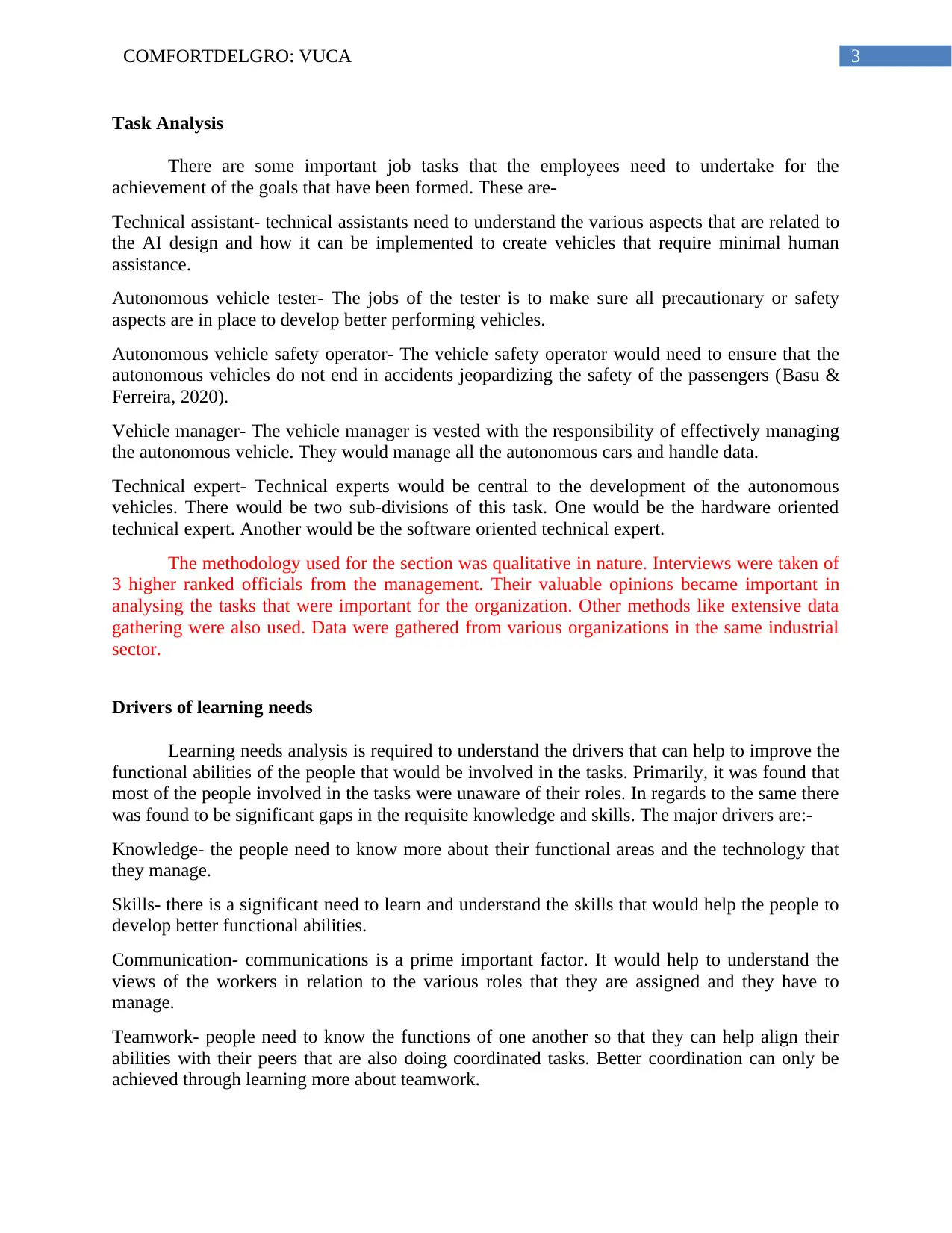
3COMFORTDELGRO: VUCA
Task Analysis
There are some important job tasks that the employees need to undertake for the
achievement of the goals that have been formed. These are-
Technical assistant- technical assistants need to understand the various aspects that are related to
the AI design and how it can be implemented to create vehicles that require minimal human
assistance.
Autonomous vehicle tester- The jobs of the tester is to make sure all precautionary or safety
aspects are in place to develop better performing vehicles.
Autonomous vehicle safety operator- The vehicle safety operator would need to ensure that the
autonomous vehicles do not end in accidents jeopardizing the safety of the passengers (Basu &
Ferreira, 2020).
Vehicle manager- The vehicle manager is vested with the responsibility of effectively managing
the autonomous vehicle. They would manage all the autonomous cars and handle data.
Technical expert- Technical experts would be central to the development of the autonomous
vehicles. There would be two sub-divisions of this task. One would be the hardware oriented
technical expert. Another would be the software oriented technical expert.
The methodology used for the section was qualitative in nature. Interviews were taken of
3 higher ranked officials from the management. Their valuable opinions became important in
analysing the tasks that were important for the organization. Other methods like extensive data
gathering were also used. Data were gathered from various organizations in the same industrial
sector.
Drivers of learning needs
Learning needs analysis is required to understand the drivers that can help to improve the
functional abilities of the people that would be involved in the tasks. Primarily, it was found that
most of the people involved in the tasks were unaware of their roles. In regards to the same there
was found to be significant gaps in the requisite knowledge and skills. The major drivers are:-
Knowledge- the people need to know more about their functional areas and the technology that
they manage.
Skills- there is a significant need to learn and understand the skills that would help the people to
develop better functional abilities.
Communication- communications is a prime important factor. It would help to understand the
views of the workers in relation to the various roles that they are assigned and they have to
manage.
Teamwork- people need to know the functions of one another so that they can help align their
abilities with their peers that are also doing coordinated tasks. Better coordination can only be
achieved through learning more about teamwork.
Task Analysis
There are some important job tasks that the employees need to undertake for the
achievement of the goals that have been formed. These are-
Technical assistant- technical assistants need to understand the various aspects that are related to
the AI design and how it can be implemented to create vehicles that require minimal human
assistance.
Autonomous vehicle tester- The jobs of the tester is to make sure all precautionary or safety
aspects are in place to develop better performing vehicles.
Autonomous vehicle safety operator- The vehicle safety operator would need to ensure that the
autonomous vehicles do not end in accidents jeopardizing the safety of the passengers (Basu &
Ferreira, 2020).
Vehicle manager- The vehicle manager is vested with the responsibility of effectively managing
the autonomous vehicle. They would manage all the autonomous cars and handle data.
Technical expert- Technical experts would be central to the development of the autonomous
vehicles. There would be two sub-divisions of this task. One would be the hardware oriented
technical expert. Another would be the software oriented technical expert.
The methodology used for the section was qualitative in nature. Interviews were taken of
3 higher ranked officials from the management. Their valuable opinions became important in
analysing the tasks that were important for the organization. Other methods like extensive data
gathering were also used. Data were gathered from various organizations in the same industrial
sector.
Drivers of learning needs
Learning needs analysis is required to understand the drivers that can help to improve the
functional abilities of the people that would be involved in the tasks. Primarily, it was found that
most of the people involved in the tasks were unaware of their roles. In regards to the same there
was found to be significant gaps in the requisite knowledge and skills. The major drivers are:-
Knowledge- the people need to know more about their functional areas and the technology that
they manage.
Skills- there is a significant need to learn and understand the skills that would help the people to
develop better functional abilities.
Communication- communications is a prime important factor. It would help to understand the
views of the workers in relation to the various roles that they are assigned and they have to
manage.
Teamwork- people need to know the functions of one another so that they can help align their
abilities with their peers that are also doing coordinated tasks. Better coordination can only be
achieved through learning more about teamwork.
Paraphrase This Document
Need a fresh take? Get an instant paraphrase of this document with our AI Paraphraser
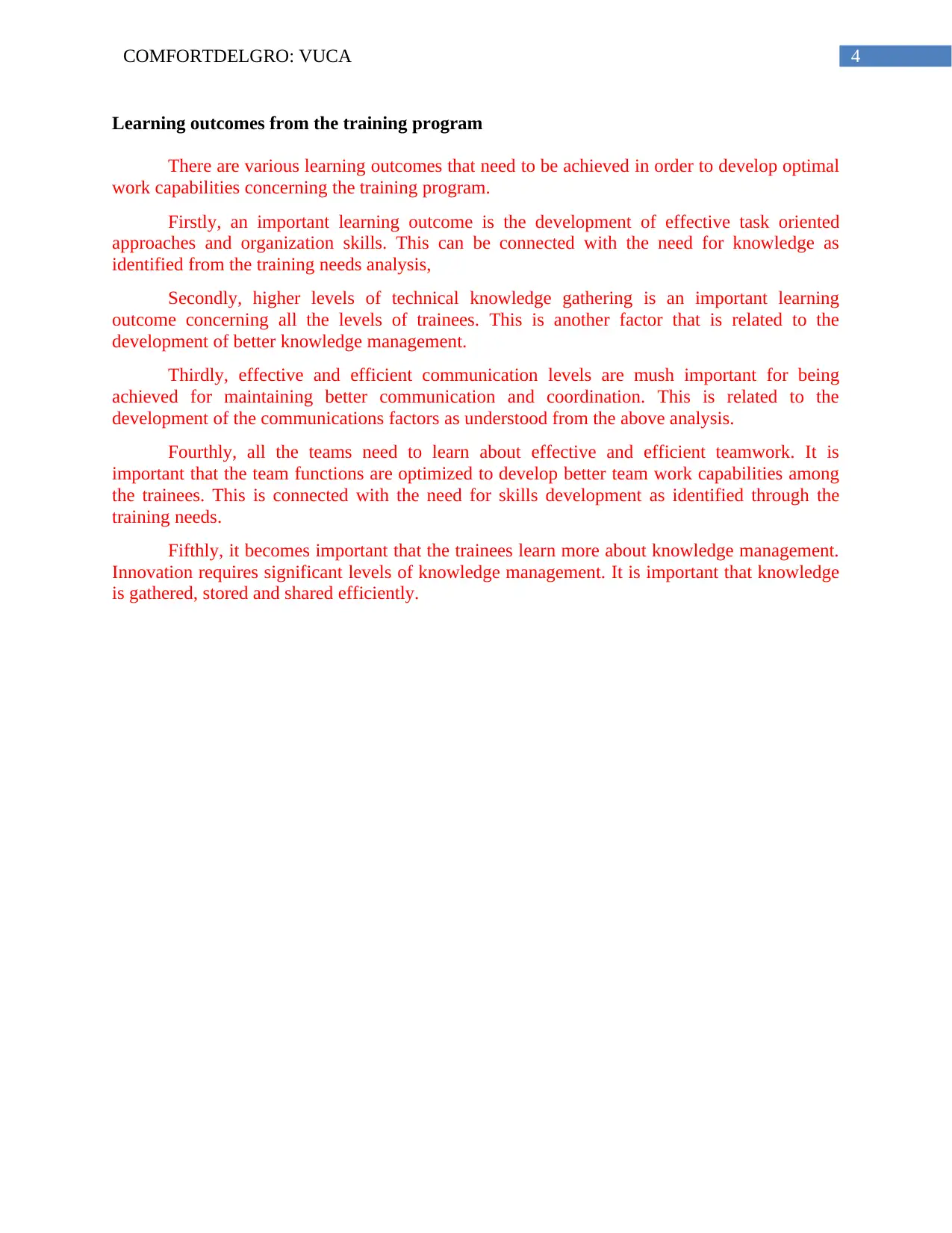
4COMFORTDELGRO: VUCA
Learning outcomes from the training program
There are various learning outcomes that need to be achieved in order to develop optimal
work capabilities concerning the training program.
Firstly, an important learning outcome is the development of effective task oriented
approaches and organization skills. This can be connected with the need for knowledge as
identified from the training needs analysis,
Secondly, higher levels of technical knowledge gathering is an important learning
outcome concerning all the levels of trainees. This is another factor that is related to the
development of better knowledge management.
Thirdly, effective and efficient communication levels are mush important for being
achieved for maintaining better communication and coordination. This is related to the
development of the communications factors as understood from the above analysis.
Fourthly, all the teams need to learn about effective and efficient teamwork. It is
important that the team functions are optimized to develop better team work capabilities among
the trainees. This is connected with the need for skills development as identified through the
training needs.
Fifthly, it becomes important that the trainees learn more about knowledge management.
Innovation requires significant levels of knowledge management. It is important that knowledge
is gathered, stored and shared efficiently.
Learning outcomes from the training program
There are various learning outcomes that need to be achieved in order to develop optimal
work capabilities concerning the training program.
Firstly, an important learning outcome is the development of effective task oriented
approaches and organization skills. This can be connected with the need for knowledge as
identified from the training needs analysis,
Secondly, higher levels of technical knowledge gathering is an important learning
outcome concerning all the levels of trainees. This is another factor that is related to the
development of better knowledge management.
Thirdly, effective and efficient communication levels are mush important for being
achieved for maintaining better communication and coordination. This is related to the
development of the communications factors as understood from the above analysis.
Fourthly, all the teams need to learn about effective and efficient teamwork. It is
important that the team functions are optimized to develop better team work capabilities among
the trainees. This is connected with the need for skills development as identified through the
training needs.
Fifthly, it becomes important that the trainees learn more about knowledge management.
Innovation requires significant levels of knowledge management. It is important that knowledge
is gathered, stored and shared efficiently.
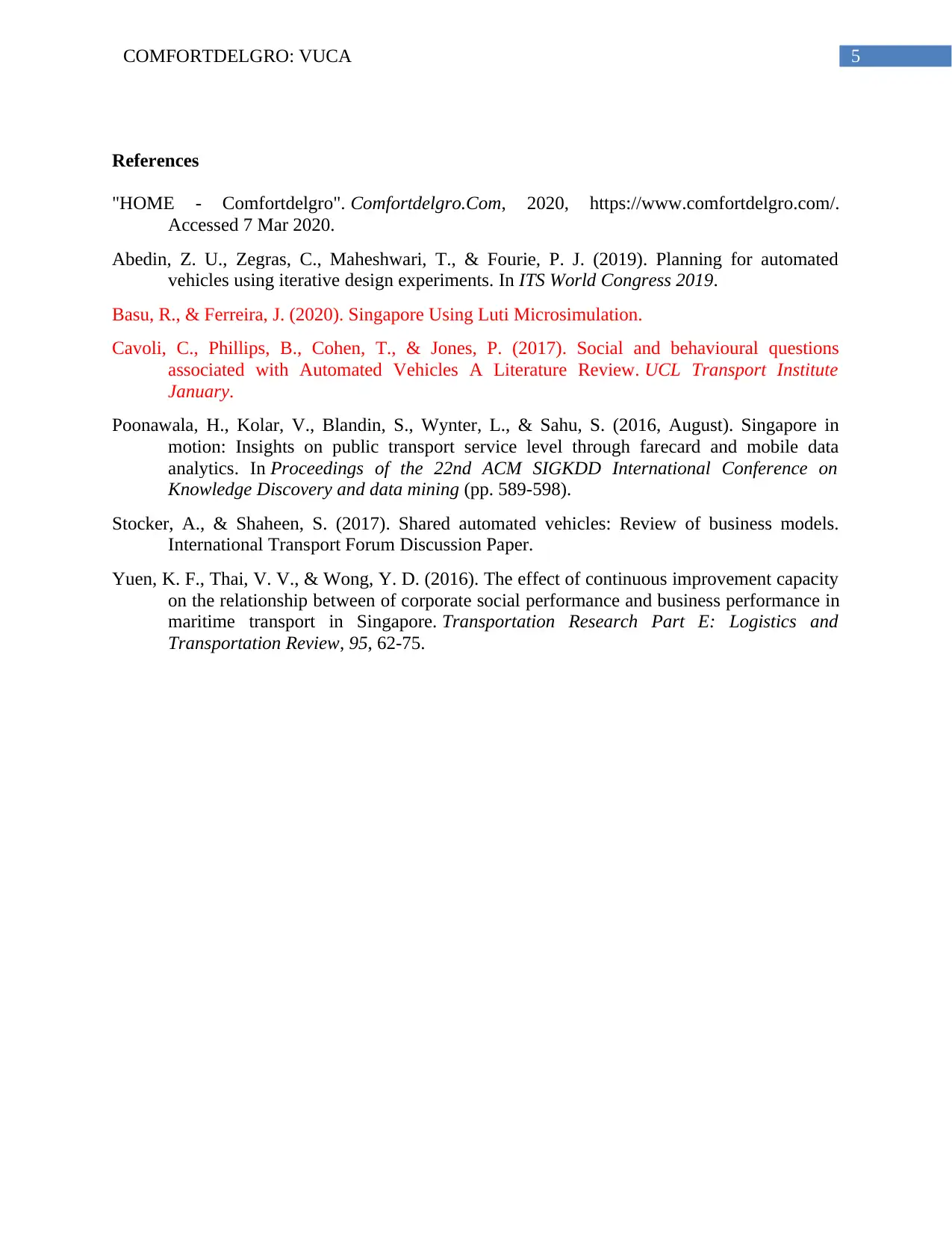
5COMFORTDELGRO: VUCA
References
"HOME - Comfortdelgro". Comfortdelgro.Com, 2020, https://www.comfortdelgro.com/.
Accessed 7 Mar 2020.
Abedin, Z. U., Zegras, C., Maheshwari, T., & Fourie, P. J. (2019). Planning for automated
vehicles using iterative design experiments. In ITS World Congress 2019.
Basu, R., & Ferreira, J. (2020). Singapore Using Luti Microsimulation.
Cavoli, C., Phillips, B., Cohen, T., & Jones, P. (2017). Social and behavioural questions
associated with Automated Vehicles A Literature Review. UCL Transport Institute
January.
Poonawala, H., Kolar, V., Blandin, S., Wynter, L., & Sahu, S. (2016, August). Singapore in
motion: Insights on public transport service level through farecard and mobile data
analytics. In Proceedings of the 22nd ACM SIGKDD International Conference on
Knowledge Discovery and data mining (pp. 589-598).
Stocker, A., & Shaheen, S. (2017). Shared automated vehicles: Review of business models.
International Transport Forum Discussion Paper.
Yuen, K. F., Thai, V. V., & Wong, Y. D. (2016). The effect of continuous improvement capacity
on the relationship between of corporate social performance and business performance in
maritime transport in Singapore. Transportation Research Part E: Logistics and
Transportation Review, 95, 62-75.
References
"HOME - Comfortdelgro". Comfortdelgro.Com, 2020, https://www.comfortdelgro.com/.
Accessed 7 Mar 2020.
Abedin, Z. U., Zegras, C., Maheshwari, T., & Fourie, P. J. (2019). Planning for automated
vehicles using iterative design experiments. In ITS World Congress 2019.
Basu, R., & Ferreira, J. (2020). Singapore Using Luti Microsimulation.
Cavoli, C., Phillips, B., Cohen, T., & Jones, P. (2017). Social and behavioural questions
associated with Automated Vehicles A Literature Review. UCL Transport Institute
January.
Poonawala, H., Kolar, V., Blandin, S., Wynter, L., & Sahu, S. (2016, August). Singapore in
motion: Insights on public transport service level through farecard and mobile data
analytics. In Proceedings of the 22nd ACM SIGKDD International Conference on
Knowledge Discovery and data mining (pp. 589-598).
Stocker, A., & Shaheen, S. (2017). Shared automated vehicles: Review of business models.
International Transport Forum Discussion Paper.
Yuen, K. F., Thai, V. V., & Wong, Y. D. (2016). The effect of continuous improvement capacity
on the relationship between of corporate social performance and business performance in
maritime transport in Singapore. Transportation Research Part E: Logistics and
Transportation Review, 95, 62-75.
⊘ This is a preview!⊘
Do you want full access?
Subscribe today to unlock all pages.

Trusted by 1+ million students worldwide
1 out of 6
Related Documents
Your All-in-One AI-Powered Toolkit for Academic Success.
+13062052269
info@desklib.com
Available 24*7 on WhatsApp / Email
![[object Object]](/_next/static/media/star-bottom.7253800d.svg)
Unlock your academic potential
Copyright © 2020–2025 A2Z Services. All Rights Reserved. Developed and managed by ZUCOL.





